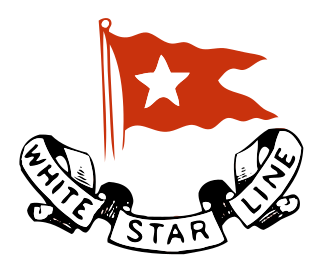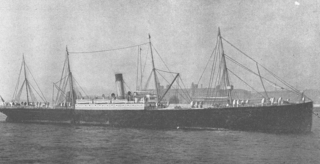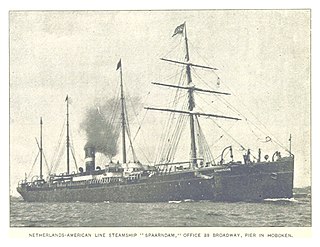
The White Star Line was a former British shipping line. Founded out of the remains of a defunct packet company, it gradually rose up to become one of the most prominent shipping companies in the world, providing passenger and cargo services between the British Empire and the United States. While many other shipping lines focused primarily on speed, White Star branded their services by focusing more on providing comfortable passages for both upper and lower class travellers.
The Wigham Richardson shipbuilding company was named after its founder, John Wigham Richardson (1837-1908), the son of Edward Richardson, a tanner from Newcastle upon Tyne, and Jane Wigham from Edinburgh.

SS Britannic was an ocean liner of the White Star Line. It was the first of three ships of the White Star Line to sail with the Britannic name.

RMS Cedric was an ocean liner owned by the White Star Line. She was the second of a quartet of ships over 20,000 tons, dubbed the Big Four, and was the largest vessel in the world at the time of her entering service. Her career, peppered with collisions and minor incidents, took place mainly on the route from Liverpool to New York.
SS Tropic was a steamship operated by the White Star Line. Built in 1871 by shipbuilders Thos. Royden & Co, the 2,122 gross register ton vessel operated on the Liverpool to Calcutta run in 1871, and in 1872 began serving South American ports from Liverpool. In 1873, the ship was sold to Serra y Font, Bilbao, and renamed Federico. She was operated by the white star line. She served alongside her sister ship, RMS Asiatic.
SS Asiatic was a steamship operated by the White Star Line from 1871 to 1873, a sister ship to Tropic. Sold off after only two years, she was renamed SS Ambriz, and eventually was wrecked in 1903.

SS Republic was an ocean liner built in 1871 by Harland and Wolff for White Star Line. It was intended to be the last of four vessels forming the Oceanic-class, before two new ships were commissioned. After a rough maiden voyage from Liverpool to New York City on 1 February 1872, the ship was chosen to be on White Star Line's first voyage on the South Atlantic and Pacific line with four other ships, destined for Chile. In 1874, the construction of modern ships SS Germanic and SS Britannic led to SS Republic's becoming the standby vessel of White Star Line. It occupied this position for 15 years, and attempts were made to modernise it in 1888. When RMS Teutonic and RMS Majestic entered service in the following year, the Republic became surplus to White Star's needs.

Lavia was a cruise ship that caught fire and sank in Hong Kong Harbour in 1989. She was built for Cunard White Star Line in 1947 as the cargo liner Media. In 1961 she was sold to Italy, rebuilt as an ocean liner and renamed Flavia. In 1969, she was refitted as a cruise ship and renamed Flavian. In 1982 she was sold to Panama and renamed Lavia. She was undergoing a refit when the fire occurred. The damage to her was so great that she was scrapped.
SS Belgic was a steamship of the White Star Line. The first of the company's four ships bearing this name, she was first assigned, with her sister ship, the Gaelic on the route to France and South America, where the company has recently tried to establish itself. The experience was short-lived, however, and at the end of the year, the Belgic was the last White Star Line steamer to serve on this route. She was then moved to the North Atlantic route.
SS Nomadic was a steamship of the White Star Line. She was laid down in 1891, in yard 236 at Harland and Wolff Shipyards, Belfast, as a livestock carrier and completed on 14 April 1891.

SS Bovic was a steamship built by Harland and Wolff in Belfast for the White Star Line.

SS Haverford was an American transatlantic liner commissioned in 1901 for the American Line on the route from Southampton to New York, then quickly on the route from Liverpool to Boston and Philadelphia. During her early years, this ship, mainly designed to transport migrants and goods, was the victim of several incidents. Her company was integrated into the International Mercantile Marine Co. (IMM) in 1902 and she was used by other companies within the trust, the Dominion Line and the Red Star Line.

SS Arabic was a steamship of the White Star Line and its first steel-hulled vessel. Like her predecessors, she was built by shipbuilders Harland and Wolff of Belfast.
The SS Belgic was a steam ship built by Harland and Wolff for the White Star Line for service in the Far East and across the Pacific. Sold to the Atlantic Transport Line in 1899 she was transferred to the North Atlantic. After service as a Boer War transport she was scrapped in 1903.

The Oceanic class were a group of six ocean liners built by Harland and Wolff at Belfast, for the White Star Line, for the transatlantic service. They were the company's first generation of steamships to serve the North Atlantic passenger trade, entering service between 1871 and 1872.

The SS Runic was a steamship built at Harland and Wolff in Belfast for the White Star Line which entered service in 1901. Runic was the fourth of five Jubilee-class ocean liners built for White Star's Australia service along with her sister ship SS Suevic, where she ran on the Liverpool–Cape Town–Sydney route. She served this route until she was requisitioned for use as a war transport between 1915 and 1919, before returning to the Australia service.

The SS Scandinavian was a steamship built at Harland & Wolff in Belfast which entered service as an ocean liner in 1898. The ship changed names and owners several times; she was originally built for the Dominion Line and was known as New England, in 1903 she was transferred to the White Star Line and renamed Romanic. In 1912 she was sold to the Allan Line and renamed Scandinavian, the name which she retained for the rest of her career.
Several ships have borne the name SS Cufic:

The SS European was a steamship built by Harland and Wolff in Belfast, which entered service in 1897. the European was a combined cargo and passenger ship which was originally built for the West India and Pacific Steamship Company along with her sister ship the SS American. In 1904 she passed to the White Star Line and was renamed Tropic, the name she retained until she was sold to Italian ownership in 1924, after which she became known as Artico then Transilvania until being scrapped in 1933.

The Jubilee class were a group of five passenger and cargo ocean liners built by Harland and Wolff at Belfast, for the White Star Line, specifically for the White Star Line's service from the UK to Australia on the Liverpool–Cape Town–Sydney route. The five ships in order of the dates they entered service were:













